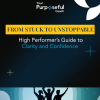
“I don’t get it—I deliver results, but I’m still being passed over.”
That’s what a client told me in session recently.
On paper, she was the perfect candidate for a bigger role. She had the expertise, the track record, the results. But her growth had stalled.
What was missing wasn’t knowledge or skill.
It was the quieter set of capabilities no one puts in a job description: the ability to lead yourself, regulate your emotions, and connect with others in ways that build trust.
The Invisible Ceiling
Here’s what I observe with high-achieving professionals:
They can analyze complex data, manage intricate projects, and solve technical problems with ease.
But ask them to handle a difficult conversation with a team member, manage their own stress during uncertainty, or build trust across different departments, and they struggle.
Neuroscience gives us a clue here: under pressure, the brain defaults to familiar patterns. For high-achievers, that usually means doubling down on technical strengths – working harder, adding hours, stacking more certifications.
But promotions aren’t handed out for “more of the same.” They’re given to people others trust to navigate complexity, manage emotions, and lead through uncertainty.
That’s the invisible ceiling: it’s not about what you know, but about how you show up.
The same way you learned to use Excel or manage budgets, emotional intelligence can be developed through intentional practice, and can be a true differentiator at senior levels.
The Inner Skills that Unlock Leadership Growth
After working with hundreds of coaching clients , these are the capabilities I see in leaders who don’t just succeed, but continue to rise
1. Emotional Self-Awareness: Knowing Your Inner Landscape
This is your ability to notice your emotional triggers before they arise and understand how they influence your decisions, communication, and leadership presence.
Most leaders are emotionally reactive without realizing it.
They make decisions from stress, communicate from frustration, or avoid difficult conversations..
What this looks like in practice:
- Noticing when anxiety is driving your perfectionism
- Recognizing that your impatience in meetings is actually excitement about possibilities
- Understanding that your resistance to feedback often stems from fear
Neuroscience shows that simply naming an emotion (“I feel anxious”) calms the amygdala and creates space for intentional response.
How to develop it:
- Daily emotional check-ins: Spend five minutes each morning asking, “What am I feeling right now, and what might be driving it?”
- Weekly pattern recognition: At the end of each week, reflect on what emotions showed up most frequently and in what situations
- Trigger mapping: Identify the specific people, situations, or conversations that consistently create strong emotional responses
2. Emotional Self-Management: Creating Space Between Trigger and Response
Self-awareness is only valuable if you can do something with what you notice.
Self-management is your ability to regulate your emotions and choose your responses intentionally, especially under pressure.
When faced with difficult emotions, leaders with strong self-management feel them fully and respond from clarity rather than reactivity.
What this looks like in practice:
- Taking a pause before responding to a challenging email
- Staying calm and curious when someone disagrees with your ideas
- Managing your own anxiety so it doesn’t spread to your team during uncertain times
How to develop it:
- Conscious breathing: Practice taking three deep breaths before responding to anything that triggers a strong emotional reaction
- Cognitive reframing: When you notice stress thoughts like “This is impossible,” practice shifting to “This is complex, and I can work through it step by step”
- Response planning: Before difficult conversations, mentally rehearse how you want to show up regardless of how the other person responds
3. Social and Relational Intelligence: Reading and Responding to Others
This is your ability to understand the emotional dynamics in relationships and groups, and to respond in ways that build trust, resolve conflict, and inspire collaboration.
Leaders with strong social intelligence can read the room, adapt their communication style to different people, and create psychological safety for their teams. Harvard research on psychological safety shows that teams perform best when people feel seen, heard, and safe to contribute.
What this looks like in practice:
- Noticing when someone’s body language doesn’t match their words
- Adjusting your communication style based on what someone needs in the moment
- Addressing team tension before it becomes destructive conflict
How to develop it:
- Active observation: In meetings, spend time watching people’s energy and body language, not just listening to their words
- Empathetic inquiry: Before giving advice or solutions, ask questions that help you understand someone’s emotional experience
- Conflict as information: Instead of avoiding workplace tension, get curious about what it’s revealing about unmet needs or misaligned expectations
The Compound Effect of Emotional Intelligence
Here’s what I’ve observed: leaders who develop these three capabilities become better at managing people. They are even more innovative because they can navigate the uncertainty that comes with new ideas.
They become more influential because people trust them to handle difficult conversations with care.
They become more resilient because they have tools to manage their own stress and support others through challenges.
And they become more fulfilled because they’re leading from alignment rather than just ambition.
.
Your Next Steps
If you recognize yourself in these patterns, here are three practical ways to start developing your emotional intelligence today:
- Start with self-awareness: For the next week, set three random alarms on your phone. When they go off, pause and ask yourself, “What am I feeling right now?” Don’t judge it. Just notice.
- Practice the pause: Before your next challenging conversation, take 30 seconds to center yourself. Ask, “How do I want to show up in this interaction?”
- Get curious about others: In your next team meeting, spend half your attention listening to words and half your attention noticing energy, tone, and body language.
The Leadership You’re Growing Into
The leaders who rise to senior levels are the ones who can navigate complexity with emotional clarity.
Who can build trust even in difficult circumstances.
Who can inspire others to do their best work, even when the path forward isn’t clear.
These capabilities are developed skills.
And the work you do to develop them today will determine the kind of leader you become tomorrow.
Your Reflection
💬 Which of these three areas feels like your biggest growth opportunity?




